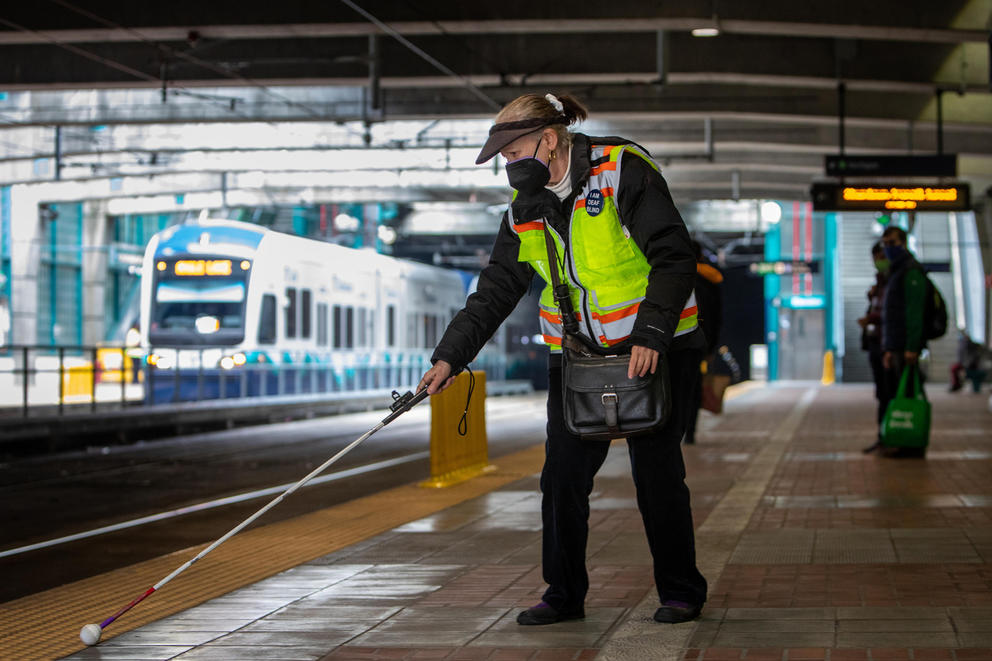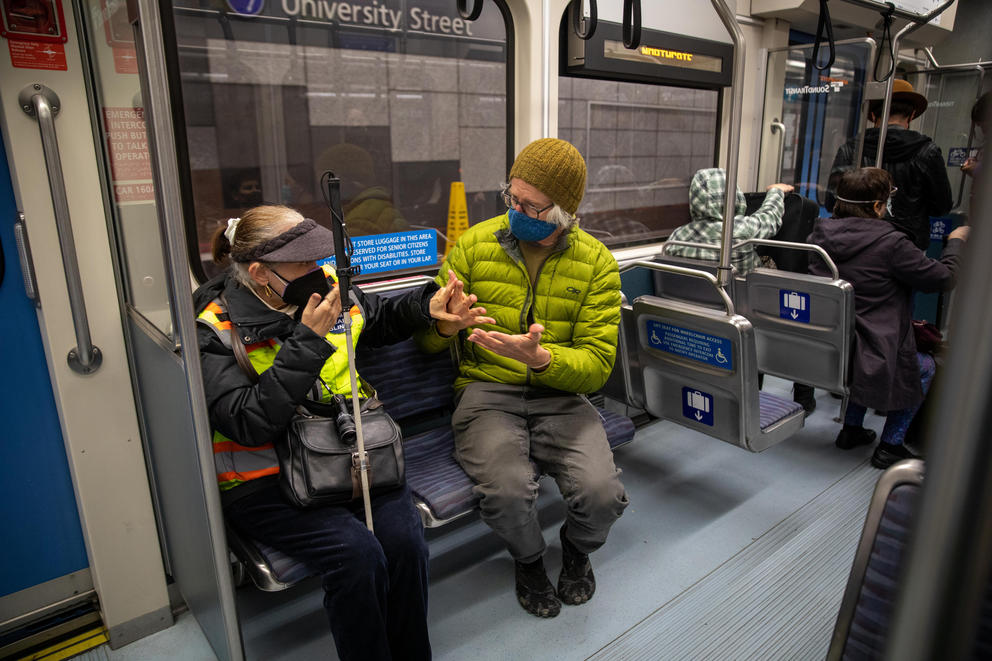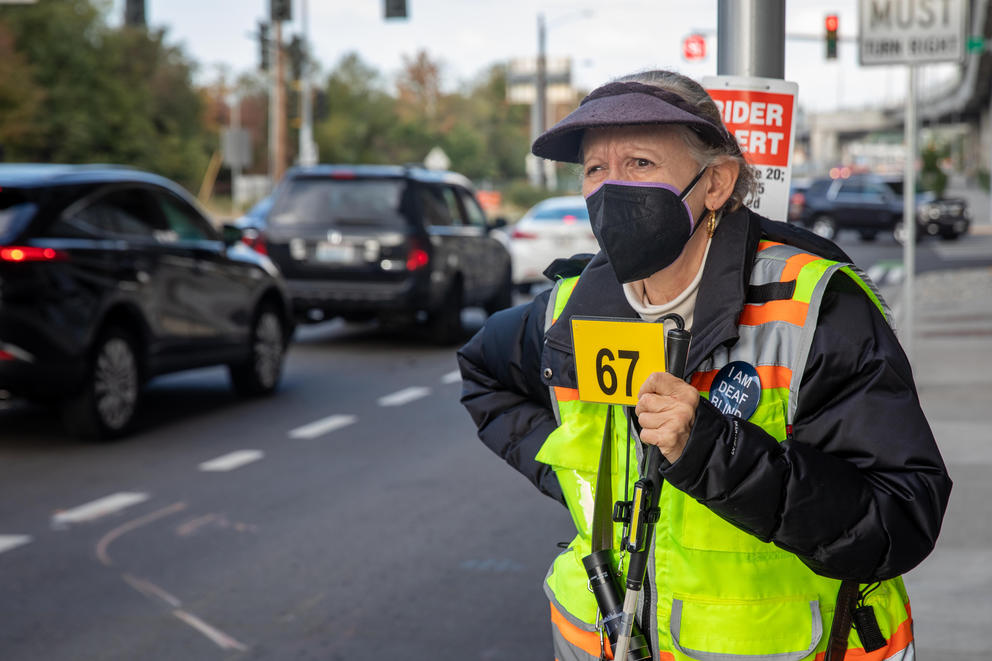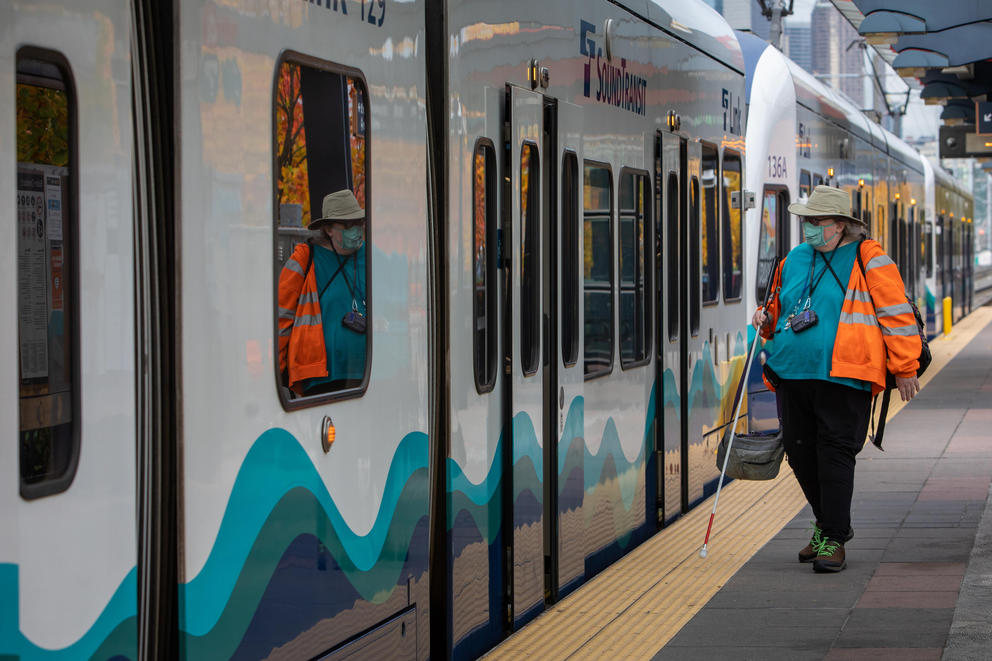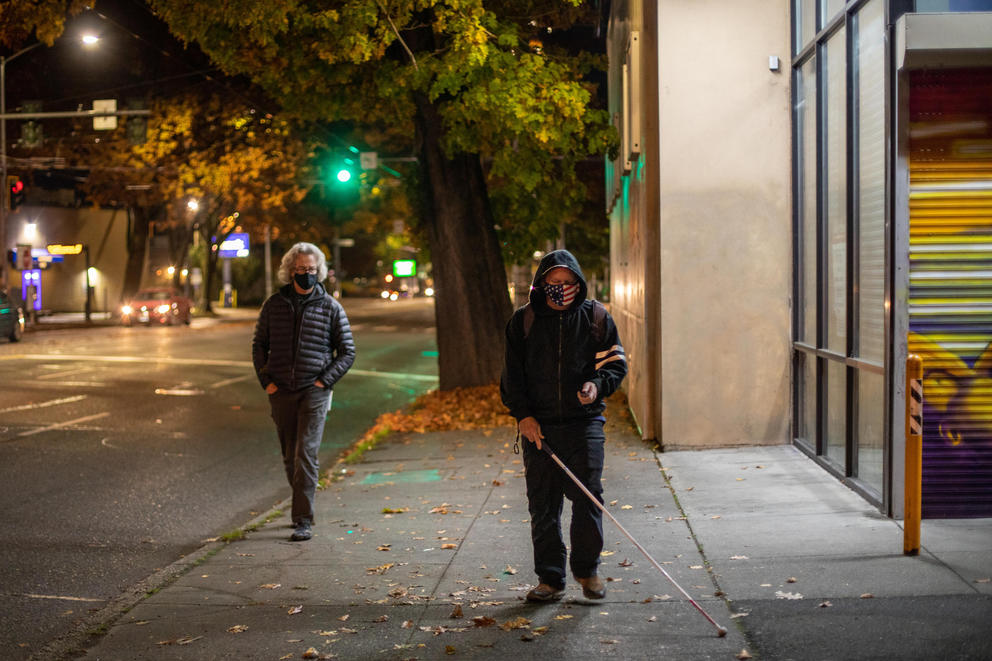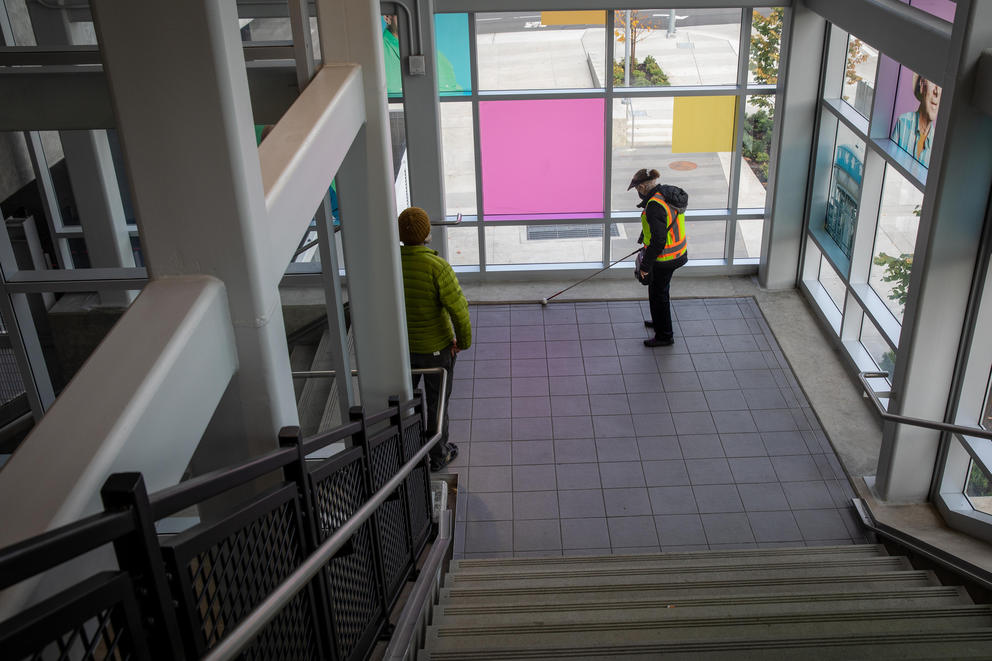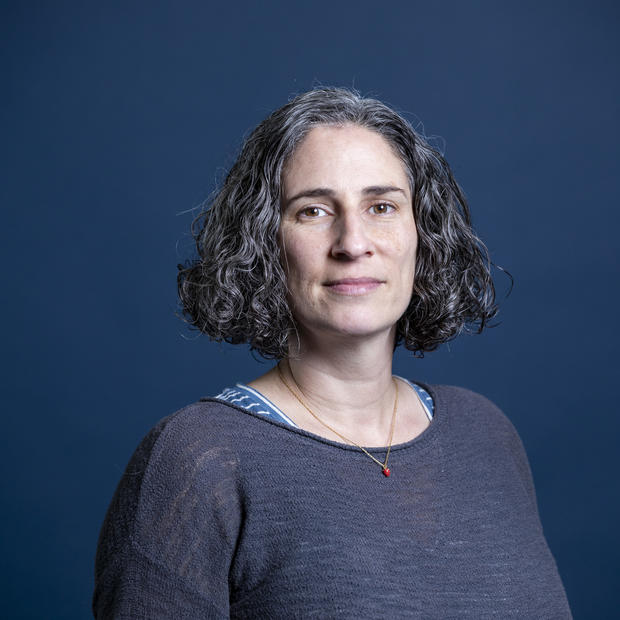Once out of the station and waiting at a bus stop, Chase whips out a card and holds it at chest level. This laminated bright yellow piece of paper — Braille on one side, a bus number on the other — is how she communicates to the driver where she wants to go.
The next day she is back at it.
Chase worked on her new routes for about three weeks before she was ready to travel alone.
With the opening of the Northgate light rail extension in October, Chase was one of thousands learning new routes as transit agencies reworked bus lines. King County Metro Transit eliminated the bus route she rode for years to her job in Seattle’s Mount Baker neighborhood, now that light rail trains offer a more reliable journey through downtown Seattle.
For three decades, she traveled by bus to her job in the sewing department at The Lighthouse for the Blind. While not initially excited about riding light rail, Chase quickly warmed to the new transit mode, which has become the longest leg of her journey home.
“Once you get on the light rail, it's so much faster — that’s what I like about it. The bus is going to take longer,” Chase said through an interpreter. “The light rail just saves so much time. I get home faster.”
Although this alternative saves her time in her daily commute, it also brings new obstacles. Navigating our regional transit system is a challenge for nearly every rider, but especially so for those with limited sight or hearing. Transferring between buses and trains, learning new routes when they come online and figuring out what to do when roads, train tracks and sidewalks intersect in inconvenient and sometimes dangerous ways can all pose extra obstacles for people who are deaf-blind.
Some of these hurdles that come with the expanded transit system are just nuisances — such as broken card readers. But others pose such a potential harm — like a train crossing that lacks accessible signals — that they will likely be avoided and circumvented by people like Chase, who are blind or deaf-blind.
Dorene Cornwell often uses this laborious and timely maneuver when broken elevators leave her no exit at light rail stations. She also does a version of it on the bus to bypass intersections she feels are unsafe to cross.
“I can read a tiny amount of normal print, but can’t see a Mack truck coming,” said Cornwell, who after years of dealing with poor eyesight from congenital cataracts became legally blind in 2004, when her retinas detached.
Though she lives a block and half from Rainier Avenue, she tries to avoid many sections and street crossings along the major thoroughfare.
Once open, the Judkins Parks station, which will straddle Interstate 90 near where the freeway crosses the lake, will become Cornwell’s home station. But if that at-grade track crossing without an APS remains in the plans at the west entrance, she will likely avoid entering on that side.
“It would be really nice if they could put in some kind of gate that came down when the train is coming,” she said, while surveying a similar pedestrian track crossing in SoDo lacking an APS. “I’m not crazy about crossing the tracks anywhere.”
Sound Transit is unable to use an APS at the Judkins Park station because the signal works on a timer, according to Donna Smith, manager of accessibility services at Sound Transit, and train arrivals and departures aren’t that exact.
“It is an issue, if you are a person who is deaf-blind, you have no way of knowing when it's safe to cross those tracks,” Smith said. “And if we are talking about having six-minute headways during the peak commute times at this station, you’ve got a lot of trains coming in and out.”
A changing transit system
In October, Sound Transit added three new light rail stations, stretching the line to 25 miles, from Northgate to Angle Lake. It’s just the first of several extensions opening in the next few years that are designed to transform how the regional public transportation system runs, as bus agencies alter routes to feed into the growing light rail network.
When EastLink starts running to Bellevue and Redmond in 2023, the Judkins Park station will become the closest light rail station to the Lighthouse. The nonprofit provides services to the blind and deaf-blind community and employs more than 200 people at a manufacturing facility, about 40 of whom are deaf-blind.
“It’s going to be great, as long as you enter and leave at the east side entrance,” said Miller, the mobility trainer at the Lighthouse.
The west access point for the Judkins Park station has plagued mobility advocates since the designs were first released: the station entrance is bookended by highway ramps with fast-moving cars trying to merge, along with a nonaccessible track crossing on the platform level. With little room to work, planners had to squeeze in light rail tracks between highway columns in an already chaotic area. As a result, riders entering on the west side will have to cross a train track to access the light rail platform.
For many, that won’t be an issue, but the lack of an "accessible pedestrian signal," or APS, at that crossing leaves blind and deaf-blind riders in potential danger. These signals vibrate and chirp — or make some sort of sound — signaling to people who are blind or deaf-blind that it’s safe to cross.
“We had noticed that particular issue early on,” Miller said. “We hoped they would have eliminated that track crossing or found an accommodation to make it safer.”
This crossing will be similar to what’s found today along the light rail route as it passes through an industrial SoDo area south of downtown near T-Mobile Park and Lumen Field, the baseball and football stadiums.
At intersections without an APS, Chase sometimes pulls out a card to ask for help crossing intersections.
“But I don’t need to do that when there’s an APS, I can do it by myself, which is cool,” Chase said.
The tactic involving the card relies on the presence of a friendly fellow traveler, so Miller developed a workaround deaf-blind travelers can execute on their own.
Rather than chance a track crossing without an APS at the SoDo station, he instructs riders to take the train one stop further, where there’s a center platform at the Stadium or Beacon Hill stations, and wait for the next train that’s going back to the SoDo station. While not the most efficient way to travel, it is the safest. When riders return to the SoDo station, they are on the side of the track they want to exit from, avoiding the at-grade track crossing that lacks an APS.
Lynn Chase waits at her bus stop, holding the route number she needs to let drivers know where she is going. “Sometimes if there aren’t any APS systems, or I’m not sure about traffic, I can pull out my card that shows another person that I am deaf-blind. And it asks them to help guide me across the street,” Chase says. “But I don’t need to do that when there’s an APS, I can do it by myself, which is cool.” (Lizz Giordano for Crosscut)
The expanding APS system
When David Miller started working with people who are deaf-blind in 1990, APS didn’t exist. Now they can be found all over Seattle.
“Deaf-blind people who live in Seattle probably use transit more than other parts of the country, partly because of the policies they have,” he said, praising local transit agencies’ push to make stations accessible.
But he sees room for improvement.
“There’s no tactile strips leading people from buses to trains. I’ve been asking for years. If they can't find a bus stop, they can’t board the bus,” Miller said. “Sound Transit architects have had a difficult time coming up with a playbook that works.”
Part of the issue, he said, is that national standards don’t exist. There’s been a push toward creating a playbook for tactile indicators, a system of pavers or mats with grooves or raised edges installed in a pattern to provide a guide for people who are blind or deaf-blind. At the Northgate station, tactile indicators lead people past ticket booths, up escalators and onto trains.
National standards would provide consistency, said Smith, with Sound Transit. “If everybody does it a little bit differently, it’s not quite as effective as it could be.”
Smith, who became blind as a toddler nearly 60 years ago, came to Sound Transit three years ago to manage the accessibility department.
“The biggest obstacle for me traveling is intersection design. It’s not so much about finding the bus, getting on the bus,” said Smith, who before the pandemic traveled from her home in Bellevue to Sound Transit’s office in Union Station by bus. “It’s about the pathway that I have to take to get to the bus stop or station.”
Smith prefers intersections with an APS and walks out of her way to avoid roundabouts.
“The intersections with the on/off ramps near Judkins Park are examples of those intersections that are hard to cross,” Smith said. “WSDOT could certainly look at reworking the on-ramps so it more reflects on-ramps in a very congested area.”
With available funding, the Washington State Department of Transportation recently eliminated one lane to the on-ramp for I-90 east, to narrow the crossing distance for pedestrians, and added flashing signs to the area, said Bart Treece, a spokesperson for the agency. The transportation agency continues to pursue additional money to study other potential safety improvements for that area, he said.
Chris Loomis and David Miller, an orientation and mobility trainer, walk from the Mount Baker light rail station to The Lighthouse. Pre-COVID he often hitched a ride with other travelers and transit employees to move from mode to mode. “Communication is really key for me to be able to navigate transit,” he said. (Lizz Giordano for Crosscut)
As for the crossing at the Judkins Park station, which doesn't have an APS Sound Transit has searched for a solution for years, before Smith joined the agency, she said.
“But there aren’t any known solutions,” Smith said. “You just have to evaluate on your own: Is this a risk I am willing to take? And how often am I willing to take it?”
Her approach would depend on how often she would use the station. She would likely look for an alternate route to circumvent the west side entrance if she used that station every day.
“If I just had to do it every once in a while, so I didn’t really care that I stood there letting train after train cross until I decided it was safe to cross, that would be different,” Smith said.
At-grade crossings are always scary, Smith said: “Traveling independently as a person who is blind or a person who is deaf-blind can be very stressful. Even if you know where you are going and what you are doing, there is just so much that requires your attention.”
I don’t know, it’s just an idea
Taking long strides, Chris Loomis bounds out from the elevator at the Mount Baker light rail station one morning in late October. On the last leg of the journey he started nearly two hours earlier leaving his house in Enumclaw, Loomis quickly reaches the first street crossing.
His cane sifts through freshly fallen leaves. The cane gives Loomis a step-and-a-half reaction time to upcoming obstacles.
He and David Miller, the transit trainer for riders with limited vision and hearing, briefly discuss his steps as they continue to work on an alternative route from the station to his job at The Lighthouse’s manufacturing facility, which sits just behind the Lowe’s in Mount Baker.
Since moving to the area in 2007, Loomis has used nearly every transit mode — ferry, bus, light and commuter rail — for his commute.
Pre-COVID he often hitched a ride with other travelers and transit employees to move from mode to mode. Station agents guided him to a seat on the Sounder train, bus drivers led him aboard and other commuters lent shoulders across streets.
Now he relies much more on his miniguide — a mobility aid used with a cane or a dog that detects objects ahead through echolocation. The little black device fits in the palm of Loomis’ hand. When on, it continually throws off an ultrasonic pulse and responds with a vibration if it identifies something within range.
“I prefer to have guidance and touch with people, and interaction with other humans,” Loomis said through an interpreter. “But social distance has really affected that option. I want to teach people how to communicate with people who are deaf-blind.”
The miniguide can be used to board trains by setting it to identify objects as close as 18 inches. After the train rolls in and the doors open, the device stops vibrating, letting him know he can enter.
It can also be deployed to cross a track without an APS, like at the Judkins Park and Sodo stations. A person could aim the miniguide at the track crossing until a train comes through. After the vibration from the miniguide triggered by a moving train stops, the user knows it's safe to cross at that moment.
Sound Transit could go the old-fashioned route and add a crossing arm, Loomis argued. The technology exists and it's cheap. “Most of the time if there is no APS that’s incredibly frustrating” he said.
“It’s already in existence, we have that technology,” Loomis said. “If there's traffic on the track, that arm comes down. And you know you can’t cross. If it’s up you know you can cross, it’s pretty simple. I don’t know, it’s just an idea.”

